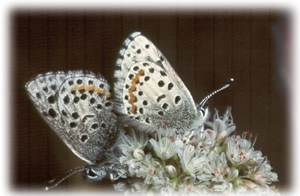Eupilotes enoptes smithi , Smith's Blue Butterfly |
|---|
 http://www.fws.gov/desfbay/Images/Smith1.jpg http://www.fws.gov/desfbay/Images/Smith1.jpgRudi Mattoni and Claude I. Smith, undergraduates at UC Berkeley, discovered the Smith’s Blue butterfly at Big Sur, California in 1948. Smith died only a few years later in a fishing accident and Mattoni named the butterfly they discovered in honor of his friend. In 1976 Smith’s Blue was one of the first insects listed under the federal Endangered Species Act. California does not allow any insect to be listed as a state endangered species, but does recognize it as a federally protected species under the CA Environmental Quality Control Act. It is also protected under the Lacey Act and by the US Fish & Wildlife Service, Department of Defense, and the US Forest Service. Smith’s Blue is a member of a family of very small butterflies, the Lycaenids. It has a wingspan of less than one inch and lives only one week, venturing less than 200 feet from its birthplace. Adults are present from early June through September. They are strictly daytime flyers and require temperatures greater than 60°F with little wind for activity. The butterflies inhabit the coastal dunes and cliffs of California from Monterey Bay south, through Big Sur, to near Point Gorda. The animals and plants that live in these areas are high adapted to their environment and will not survive in adjacent areas. Both males and females have whitish-grey undersides speckled with black dots and a band of red-orange marks crossing hind wings along with checkered fringes. Females are brown with a band of red-orange marks on their hind-wings. Males are bright blue with wide black borders and have a hairy appearance of the body and adjacent wings. Coast and Seacliff Buckwheat are the exclusive host plants of Smith’s Blue. Each plant species blooms at different times, creating a temporal breeding boundary within the species. Females lay eggs on the flower heads and one week later, larvae emerge. Larvae feed on the petals and seeds and are cryptically colored. The four larval stages, or instars, last 3-4 weeks. Pupation occurs either in the flower or leaf litter beneath the plant. If the former occurs, it will fall into the leaf litter and remain there for 47 weeks until the butterfly emerges. Lycaenid larvae have an interesting mutualistic relationship with several species of ants (Crematogaster sp., Dorymyrmex sp., Forelius sp., and Formica sp.): the ants protect the larvae from predatory spiders and parasitic wasps and the larvae secrete a sugary substance from their abdomen to feed the ants. Coastal ecosystems constitute only 10% on the United States yet more than 33% of the population live in them. It is estimated that they will contain 75% of the population by 2010. Currently, 45% of all listed threatened or endangered species (and 75% of listed bird or mammal species) inhabit coastal ecosystems. Coastal dunes have decreased in number by 50% since 1900. This is due to development, human recreation, sand mining, military activity, slope failure/slumping, and fire suppression activities. Two non-native plant species, European beach grass and South African ice plant, were introduced to stabilize sand dunes. However, they are now invasive and are destroying the buckwheat population. It has been suggested that the Smith’s Blue which feed of Coastal Buckwheat be reclassified into a subspecies, Euphilotes enoptes arenacola (“sand dweller”), to emphasize their connection with dune destruction.
|
Resources:
|
Written by: Sarah Petraitis, 2006 Updated: Eric Denemark 2008 |
Image credit: U.S. Fish and Wildlife Service |